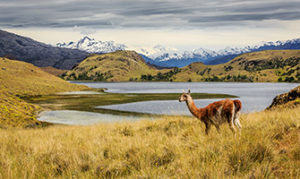A History of Parque Patagonia
As the students enjoy the last few days of their expeditions in Patagonia, Anita thought it would be nice to share a bit about the history and creation of the National Park our students explore.
Spanning from the eastern beech forests of the Andes Mountains to the western arid grasslands of the Patagonian steppe, Valle Chacabuco is a transitional ecosystem that forms the heart of the newly formed Parque Patagonia. Students at the Alzar School spend two weeks in this area. They explore the vast wilderness of Patagonia’s iconic granite spires and the meandering glacial waters of the Rio Baker. Located deep in southern Chile, Valle Chacabuco remained largely unexplored throughout Spanish colonization. As late 19th century explorers trekked steadily south, the resources of these remote areas were documented and soon exploited. As early as 1908, large-scale sheep and cattle ranching operations were established in Valle Chacabuco. Despite government re-appropriation of lands to agricultural elite and the steady degeneration of grazing lands, ranching remained a driving force in the area’s economy up until the early 2000’s.
In 1995, Doug and Kris Tompkins, founders of Patagonia clothing brand and avid conservationists, visited Valle Chacabuco hearing stories of how the rich habitats of this area naturally support a high level of biodiversity. Kris recalls her visit in a blog post, A History of Valle Chacabuco:

“When I drove through the Chacabuco Valley for the first time, I saw the extra-high ‘guanaco fences’ designed to keep these first-rate jumpers out of the best bottom grasslands, which were reserved for the cattle on the estancia. My eyes glazed over looking out on the tens of thousands of sheep grazing the bunch grasses up and down the valley. The grasses looked patchy and dead. Nothing left for wildlife.”
The guanaco, a llama relative, is a keystone species in the region and have adapted to the harsh conditions of the high steppe. They roam freely, revitalizing native vegetation and providing food for predators. This area is also home to some of South America’s most endangered species such as giant anteaters, culpeo fox, pumas, and hairy armadillos. Realizing the  ecological significance and the conservation potential of the region, Kris founded Conservacion Patagonica in 2000 with a mission, according to their website, of “building new national parks in compelling, ecologically critical areas of Patagonia.”
ecological significance and the conservation potential of the region, Kris founded Conservacion Patagonica in 2000 with a mission, according to their website, of “building new national parks in compelling, ecologically critical areas of Patagonia.”
Since it’s inception, Conservacion Patagonica has acquired large swaths of formerly ranched land and are working to restore and link contiguous natural habitats in Argentinean and Chilean Patagonia. Once complete, Parque Patagonia will become a Chilean national park and span an area roughly the size of Oregon State. Through the acquisition of former ranching lands, extensive ecological restoration efforts and the eventual donation of these areas back to government states, Conservacion Patagonica is making an impact and setting precedent for large-scale land conservation across the globe. Read more about Conservacion Patagonica and the history of Parque Patagonia. Photos courtesy of Parque Patagonia website.

